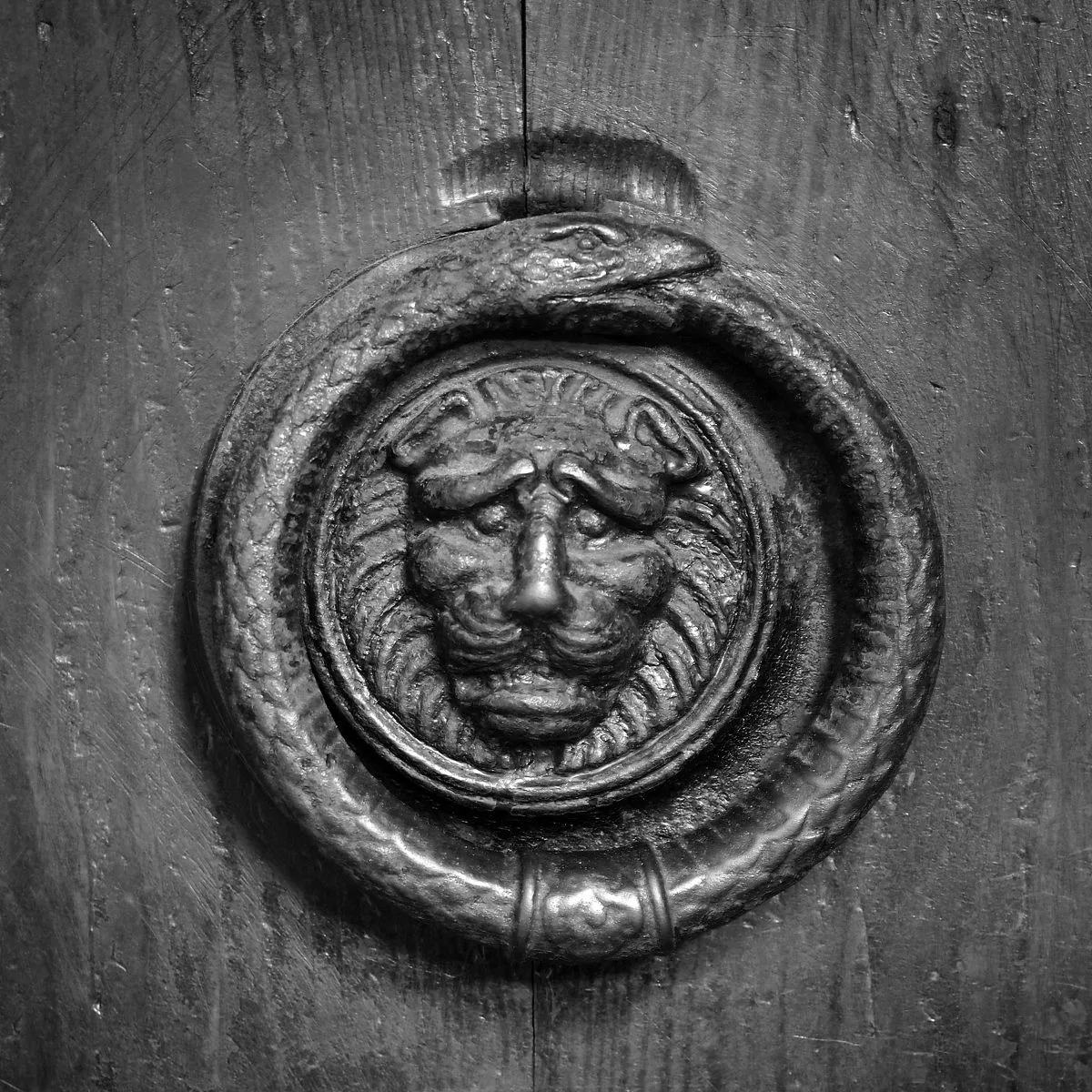From the sands of ancient Egypt to the mystical texts of Alchemy, the ouroboros has slithered its way through history, encapsulating a wisdom as profound as the universe itself.
This serpent, locked in an eternal cycle of consuming its own tail, serves not only as a symbol of the continuity of life but also as a key to unlocking the mysteries of our existence.
The spiritual meaning of the ouroboros is a rich tapestry woven from threads of renewal, transformation, and the eternal unity of all things.
As we unravel the layers of this ancient emblem, we discover insights into our personal journeys, the natural world, and the interconnectedness of life and spirit.
Join us as we explore the ouroboros’ timeless message, illuminating paths of understanding and enlightenment in our complex, modern lives.
Ouroboros Spiritual Meaning
In the tapestry of symbols that stretch across human history, few are as enigmatic and universally resonant as the ouroboros.
This ancient emblem, a serpent consuming its own tail, emerges from the mystical sands of Egypt and the philosophical realms of Greece, carrying with it a profound narrative about the nature of existence.
It’s a narrative that transcends the mere physical depiction of a snake eating itself, venturing deep into the spiritual dialogues shared by disparate cultures over centuries.
The ouroboros is not just an object of fascination but a profound teacher. Its circular form represents the cyclical nature of the universe—where everything that ends invariably begins anew in a perpetual loop of renewal.
This symbolism strikes at the core of alchemical studies and gnostic beliefs, traditions where the search for knowledge and enlightenment is deeply entwined with the mysteries of the cosmos.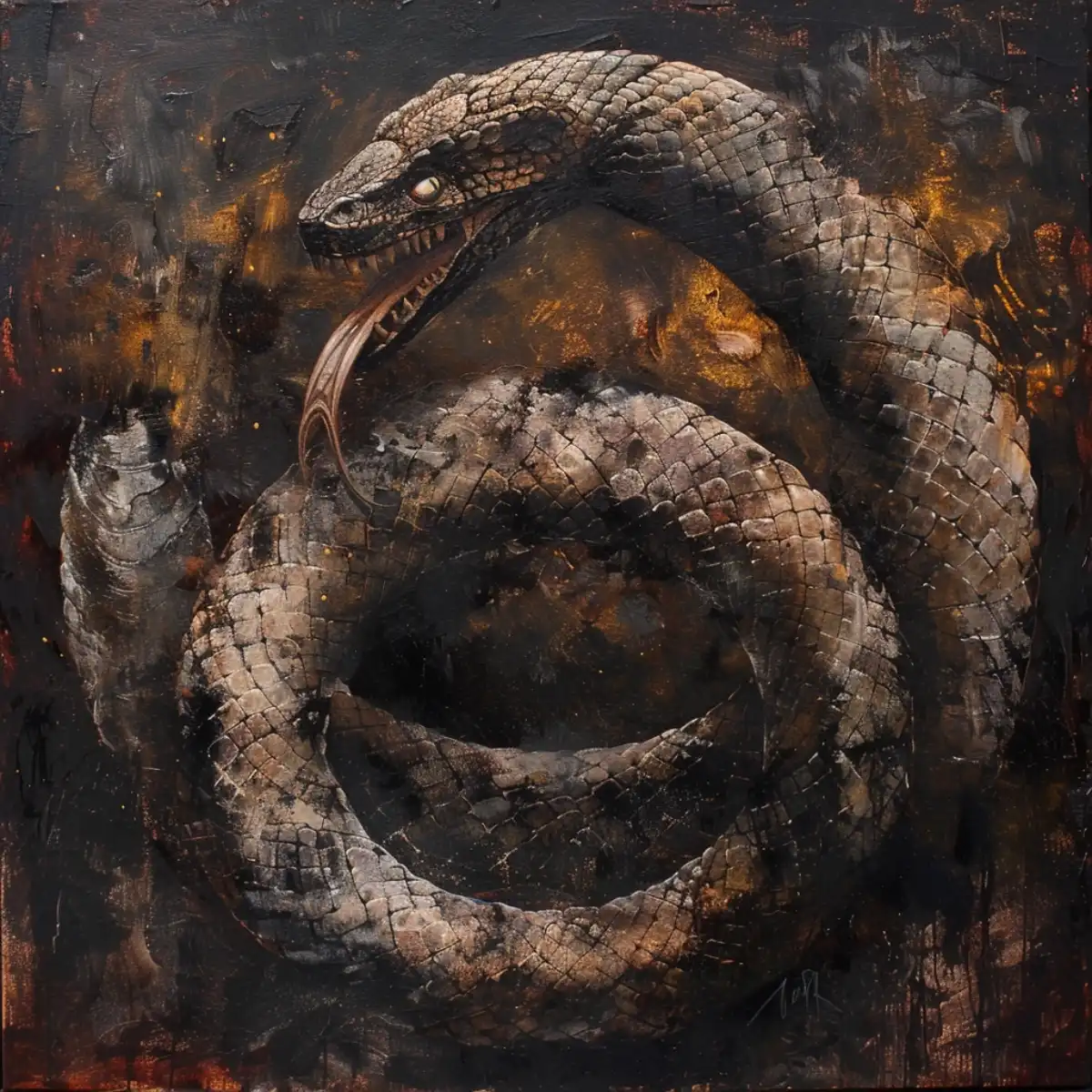
For alchemists, the ouroboros was a signifier of the magnum opus—the great work of achieving not just the literal transformation of base metals into gold but the transmutation of the human soul from its base state to divine enlightenment.
Gnosticism, with its emphasis on esoteric knowledge and the divine spark within, saw in the ouroboros a depiction of eternal unity.
It suggested that all dualities, the material and the spiritual, life and death, light and darkness, are bound in an endless cycle.
Nothing truly perishes; rather, it transforms, adopting new forms in a continuous dance of creation and dissolution.
This perspective offers a comforting continuity, a reminder of the indestructible essence of being that survives beyond the superficial changes.
Today, the ouroboros remains a potent symbol for those navigating the complexities of modern existence.
Its message is timeless, urging us to see beyond the ephemeral to the eternal cycles that govern our world.
In its simplicity lies a call to introspection—to recognize our part in the broader cycles of nature and existence.
We are reminded that our personal transformations, the shedding of past selves for new beginnings, mirror the natural world’s rhythms.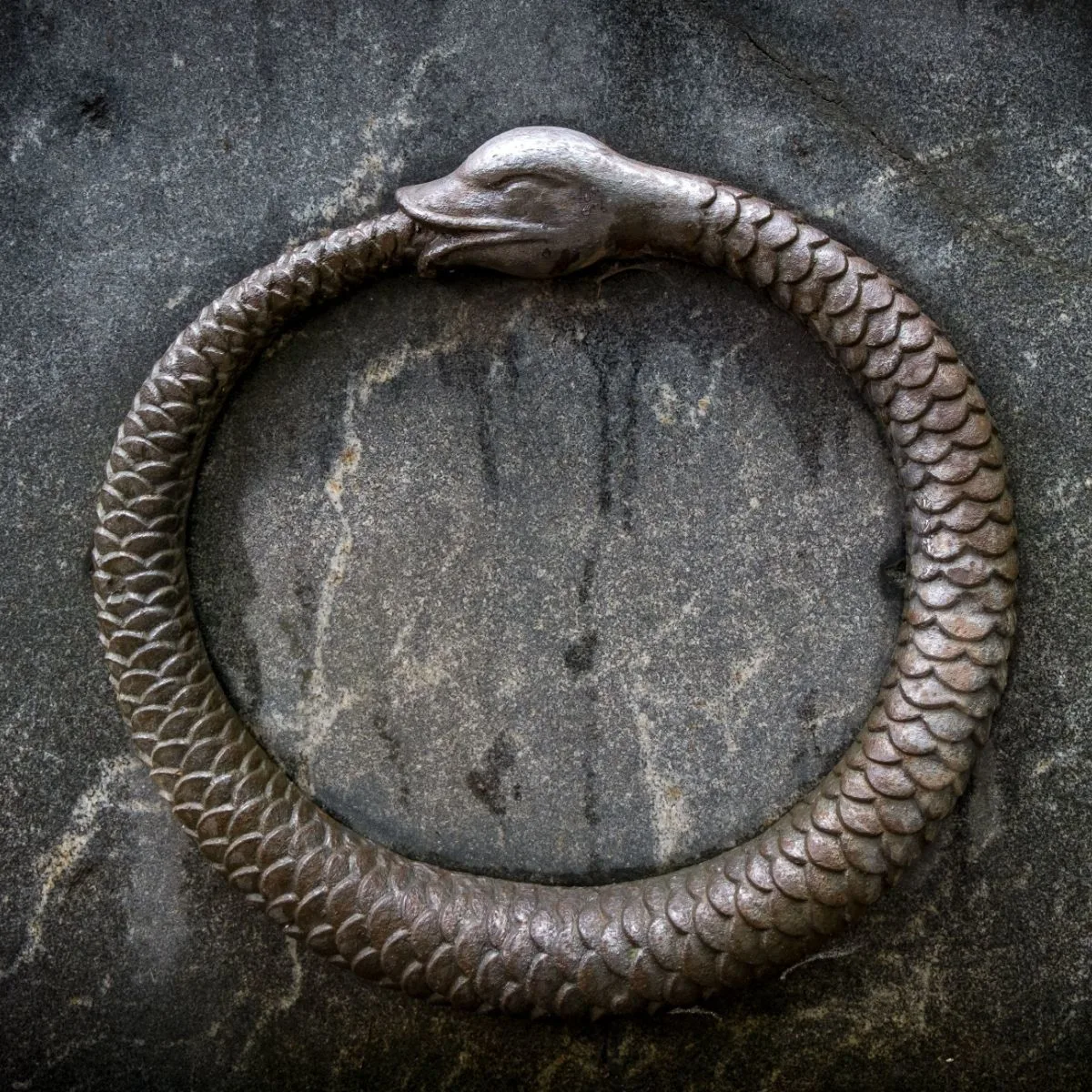
This ancient serpent invites us to contemplate our interconnectivity, suggesting a unity that defies the apparent separateness of our experiences.
It challenges us to find equilibrium between the tangible and intangible, weaving together the material and spiritual aspects of our existence into a harmonious whole.
In this balance, we find the essence of the ouroboros’ message—a promise of renewal and the infinite potential for re-creation that lies within and around us.
Thus, the ouroboros stands as a sentinel at the gateway of understanding, guarding ancient wisdom that feels remarkably pertinent today.
It beckons us to explore the depth of our being and the mysteries of the universe with a reassurance that in every ending, there’s a beginning, and in every destruction, the seeds of creation await.
Through its eternal cycle, the ouroboros embodies the unending rhythm of existence, offering a profound reflection on the continuity of life, the inevitability of change, and the interconnectedness of all things.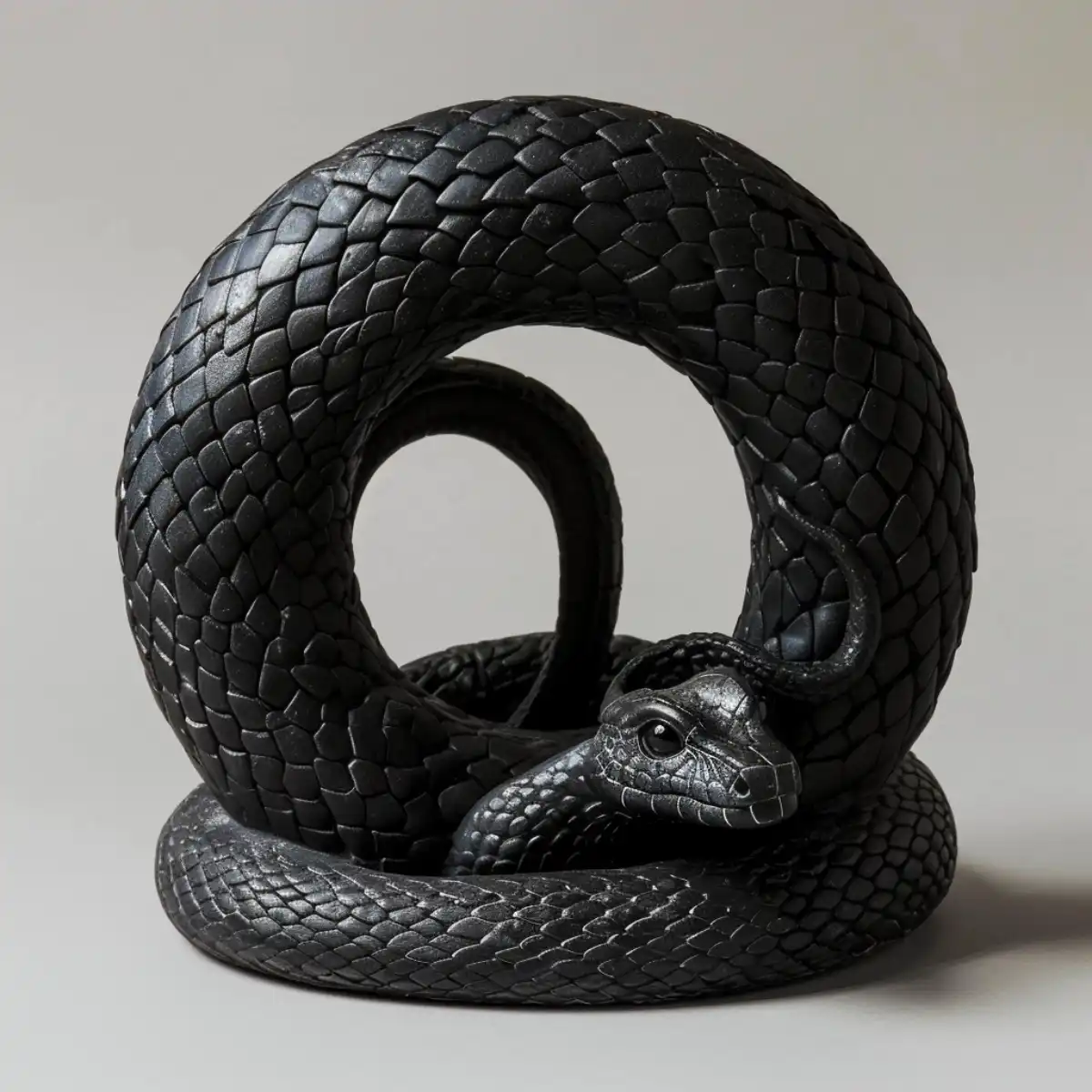
The Eternal Cycle of Beginnings and Endings
The ouroboros, an ancient emblem of a serpent consuming its own tail, stands as a profound metaphor for the eternal cycle of beginnings and endings that characterizes the essence of life itself.
This symbol, deeply rooted in the wisdom of antiquity, invites us into a contemplation of the natural rhythms and cycles that govern both the cosmos and the internal landscapes of human experience.
In observing the natural world, one cannot help but be awed by the impeccable timing and balance with which nature orchestrates the dance of life.
The autumn leaves, in their vibrant decay, paint the earth in hues of fire and gold, only to give way to the barrenness of winter—a period of rest and withdrawal.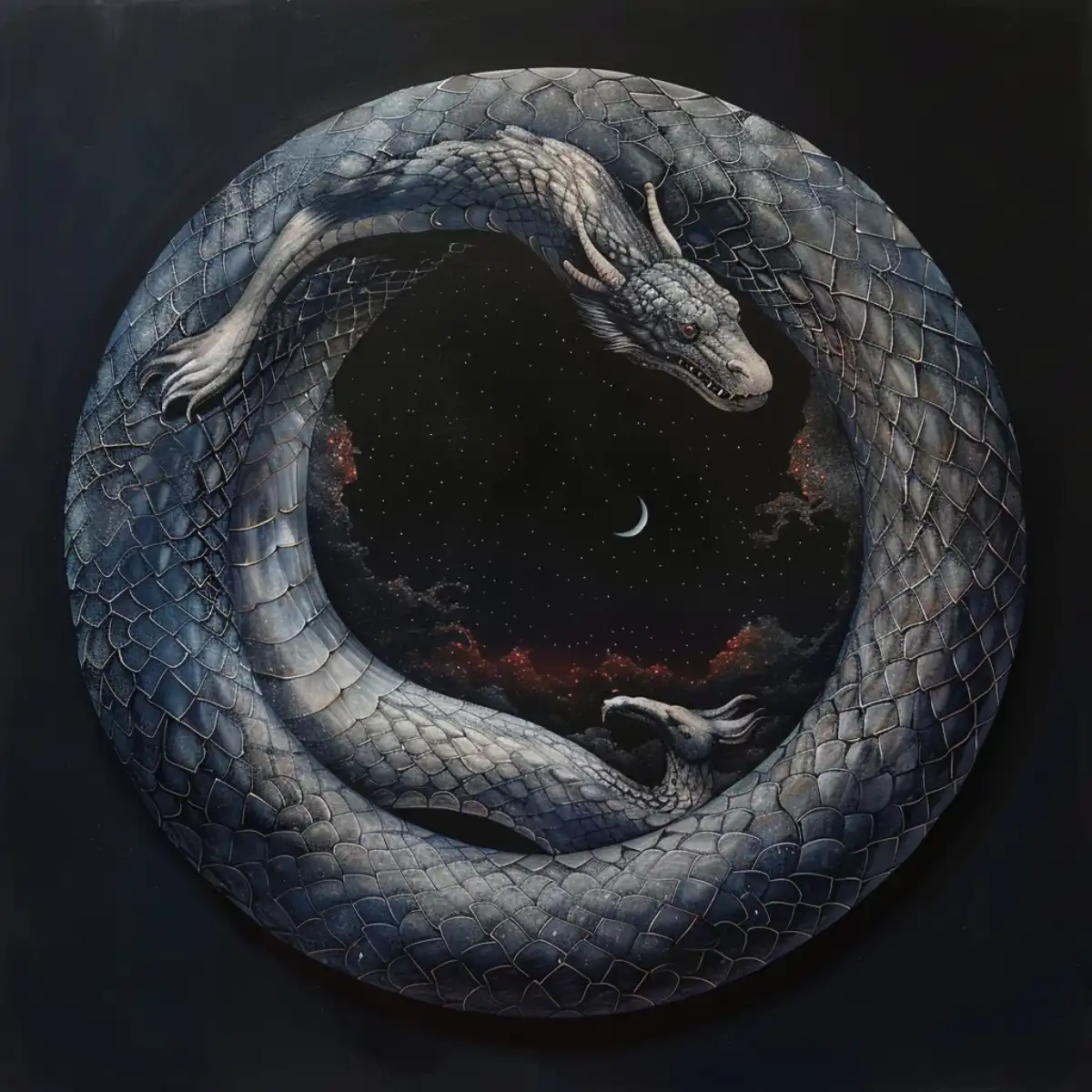
Yet, beneath the surface, life quietly brews, preparing itself for the inevitable resurgence of spring. Here, new life bursts forth in an exuberant display of vitality, closing the circle that began with decay.
This cycle, mirrored in the ouroboros’ ceaseless rotation, speaks to the heart of existence, where every ending is intrinsically linked to a new beginning.
Parallel to these natural cycles are the rhythms of human experience, where the ouroboros finds its reflection in our own lives. Each of us undergoes periods of growth and decay, success and failure, joy and sorrow.
Our personal journeys are marked by a series of endings and beginnings, where each conclusion paves the way for new opportunities and transformations.
Much like the serpent that devours its tail, we are continually evolving, shedding old versions of ourselves to emerge renewed and revitalized.
The ouroboros, therefore, serves not only as a symbol of the natural order but also as a guiding principle for personal resilience and renewal. It assures us that in every moment of loss or closure, there lies the potential for regeneration and new life.
This perspective empowers us to face the inevitable cycles of change with grace and optimism, understanding that the essence of life is not a linear progression but a continuous loop of transformation.
Furthermore, the ouroboros’ depiction of the cycle of beginnings and endings offers a compelling insight into the interconnectedness of all things.
It reminds us that our existence is not isolated but deeply woven into the fabric of the wider universe. The cycles that play out within us are reflections of greater cosmic rhythms, suggesting a universal unity in the perpetual motion of creation and dissolution.
By meditating on the eternal cycle embodied by the ouroboros, we are invited to align ourselves with the flow of life, embracing each ending as a precursor to new beginnings.
This symbol encourages us to view our lives and the world around us through a lens of cyclical continuity, where every decay is a promise of rebirth, and every conclusion opens the door to fresh starts.
In this way, the ouroboros becomes a beacon of hope and resilience, illuminating the path through the endless dance of existence, where the cycle of beginnings and endings perpetually unfolds.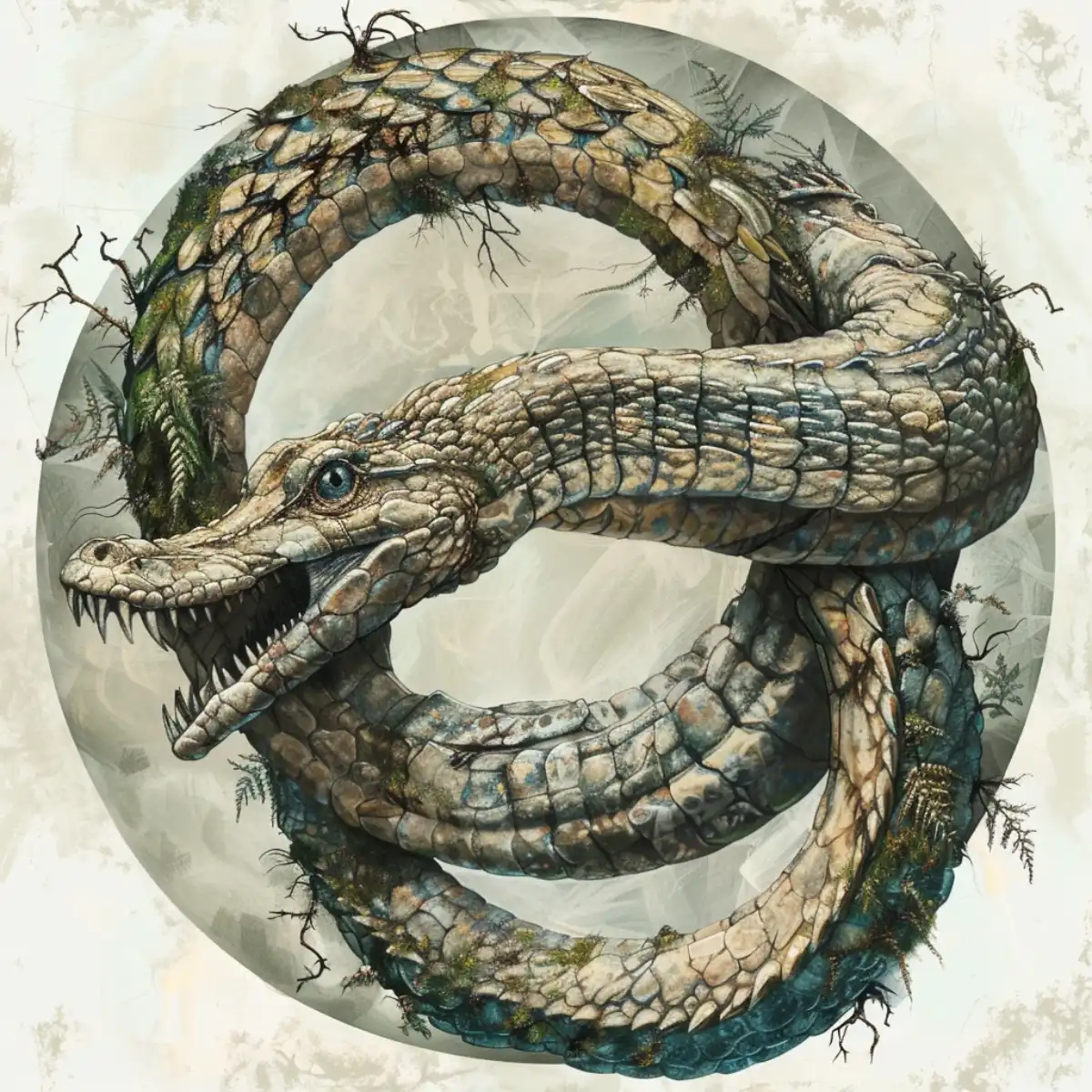
The Ouroboros in Daily Mindfulness Practices
Integrating the ouroboros into daily mindfulness and spiritual practices opens up a profound avenue for personal growth and understanding, drawing from its rich symbolism of eternal cycles of renewal and transformation.
This ancient emblem, depicting a serpent consuming its own tail, serves not simply as an object of meditation but as a guide for embodying the cyclical nature of existence in our spiritual routines.
It invites us to venture deeper into the essence of our being, encouraging practices that reflect the perpetual motion and interconnectedness of life.
When we incorporate the ouroboros into mindfulness practices, it becomes a symbol through which we can explore and accept the inherent cycles within our lives—moments of joy and sorrow, growth and retreat, birth and death.
This symbolic engagement teaches us to witness our experiences with a balanced perspective, seeing the transient nature of all things without attachment.
Each breath, each thought, and each emotion is observed as part of an ongoing cycle, much like the ouroboros endlessly consumes and recreates itself. This practice fosters an acceptance of change and flux, grounding us in the stability of life’s inherent impermanence.
The ouroboros also inspires meditations focused on personal transformation, where we visualize ourselves undergoing continuous renewal.
Just as the serpent sheds its skin, we too can shed layers of our past selves, beliefs, and patterns that no longer serve us.
This visualization fosters a deep inner transformation, aligning our personal cycles of growth with the universal cycles of creation and dissolution.
The ouroboros, in its eternal loop, reminds us that every end is a new beginning, guiding us through the process of letting go and welcoming the new with open arms.
By reflecting on the ouroboros, we learn to cultivate resilience through an awareness of life’s cyclical nature. Understanding that periods of darkness are followed by light, and hardship by ease, we equip ourselves with the strength to face life’s challenges with equanimity.
The serpent’s continuous cycle is a testament to the enduring nature of existence, offering comfort and encouragement during times of struggle.
Mindfulness practices that connect us with the rhythms of nature are also enriched by the symbolism of the ouroboros.
Engaging in activities like walking meditations in natural settings becomes an exercise in recognizing the cycles around us—the changing seasons, the phases of the moon, the life cycles of plants and animals—as reflections of the same cosmic principles depicted by the ouroboros.
This deepens our connection to the world, fostering a sense of unity and belonging that nourishes our spiritual well-being.
Lastly, contemplating the ouroboros encourages a profound appreciation for the present moment.
By acknowledging the eternal now as part of a larger, infinite cycle, we are invited to live fully in each moment, expressing gratitude for the unique opportunities and lessons it brings.
The ouroboros, with its endless loop, teaches us that every moment holds the potential for renewal and transformation, guiding us towards a more mindful, present, and spiritually fulfilled existence.
In weaving the ouroboros into our daily mindfulness and spiritual practices, we not only honor the depth of its ancient wisdom but also align ourselves more closely with the fundamental truths of life.
Through this symbolic exploration, we discover the beauty of the eternal cycle of beginnings and endings, finding within it the keys to resilience, transformation, and a deeper connection with the essence of existence.
Takeaway
In conclusion, our journey through the spiritual landscape of the ouroboros has unveiled a treasure trove of insights and wisdom that transcend time and culture.
This ancient symbol, embodying the serpent eternally consuming its own tail, serves as a profound metaphor for the infinite cycle of life’s transformations.
It bridges the gap between ancient wisdom and modern existence, offering a lens through which we can view the perpetual motion of beginnings and endings not with resignation but with a sense of wonder and possibility.
The ouroboros reminds us that in every ending lies the seed of a beginning, in every decay the promise of renewal. It teaches us to embrace change as the only constant, guiding us towards a deeper acceptance of the natural rhythms that govern the cosmos and our lives within it.
Far from being a mere historical curiosity, the ouroboros stands as a beacon of hope and resilience, encouraging us to find beauty in the cycle of life, to seek unity in diversity, and to pursue growth through transformation.
By integrating the timeless wisdom of the ouroboros into our daily lives—whether through mindfulness practices, personal reflection, or simply a greater appreciation for the natural world—we open ourselves to a more enriching and connected existence.
We are invited to participate in the eternal dance of creation and dissolution, armed with the knowledge that our spirits, like the ouroboros, are indomitable and boundless.
Thus, the ouroboros, far from being an esoteric relic of the past, emerges as a vital guide for our spiritual journeys, illuminating the path towards understanding, harmony, and self-renewal.
In its unending loop, we find a symbol of life’s enduring mystery and majesty, a reminder that even in the depths of the darkest night, the seeds of dawn are already germinating.
The ouroboros’ spiritual meaning, rich with layers and nuances, continues to evolve with us, offering endless inspiration for those willing to explore its depths.
In this light, we can view the cyclical nature of our existence not as a burden but as a gift—a canvas on which to paint our continuous voyage of discovery and transformation.
Why Do I Keep Thinking About My Ex Spiritual Meaning

